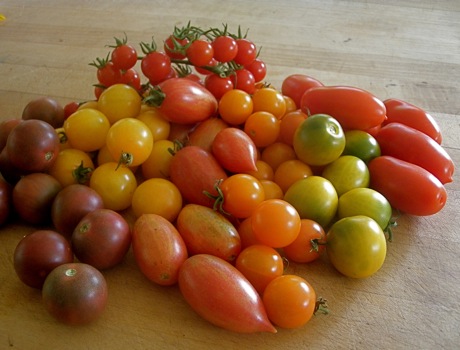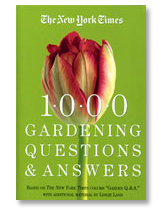Cherry Tomatoes

Our 2010 cherry tomatoes, left to right: Black Cherry, Gajo de Melon (yellow), Maglia Rosa, Sun Gold (orange), Green Grape, and Juliet, with Matt's Wild Cherry on top.
Like most Northeastern gardeners, I planted this year’s tomatoes with fear and trembling, still in shock from last year’s late blight and almost afraid to hope.
A certain amount of apprehension remains – in gardens it’s never too late for disaster – but so far, so more than good. Like everything else goosed forward by heat waves, the Hudson Valley tomatoes are way ahead of schedule. There are a lot of them and they are delicious. (Nothing like nights in the 70’s to make a tomato plant happy, no matter what they do to the rest of us.)
Unintended consequence: we are drowning in cherry tomatoes
Because they seemed to be more blight-resistant than full sized tomatoes, I planted more of them than usual. But as one of the reasons for their strength (I think) is the enormous plants they make, the fact that they are quite healthy means we’re looking at a potential tsunami of the little dears, to eat out of hand and give away – and try to decide whether to skin before using in recipes.
I don’t cook with them a lot but we do have favorites, like pasta with cherry tomatoes, prosciutto and basil cream, and cherry tomatoes stir-fried in butter. Allow me to recommend it: just cherry tomatoes and butter, over highest-possible-without-burning heat for only long enough to heat through (and brown the butter), with a sprinkle of coarse salt at the end. A revelation – in cherry tomato season, anyway.
Normally, skinning cherry tomatoes would seem silly, overrefined and maybe even a tad pretentious, but there’s no silver lining without its cloud. It may be just-right-for-tomatoes hot, but it’s also just-wrong-for-tomatoes dry and those incredibly sweet juicy morsels are wearing leather jackets.
Tasting Notes:
Black Cherry: Like all “black” tomatoes actually a dusky purple with occasional green shoulders. Rich, deep flavor with a hint of grapefruit when fully ripe, either sour or flat and insipid (go figure) right up until then.
Gajo de Melon: The bright yellow color deepens to near-apricot and the bottom gets a pink flush when they’re ripe. Flavor is sweet, mild and strongly aromatic, almost floral. Anything even a little unripe is surprisingly hard and sour.
Maglia Rosa: They all seem to have those points, and wonderful streakings of gold, apricot and green over pink. Deepening of the pink signals ripeness, but they’re pretty sweet as soon as they’re soft. It’s the complexity and classic tomato flavor that develop last.
Sungold: As usual, terrific when they hit dark gold, then sweet and spicy beyond compare at the almost orange stage. One benefit of the dry season/tough skin situtation is that they’re splitting less than usual.
Green Grape: Still slow; we’ve only had a couple of ripe ones but so far experience remains consistent: they’re bigger, fleshier and sweeter in Maine, with more of the meaty base notes that make them, when they are at their best, my favorite cherry tomatoes.
Juliet: Like Sungold an old reliable. Quite tasty as a fresh tomato though not in Sungold/Gajo/Green Grape territory. Excellent for stuffing – great nibbles! – and drying; the two uses to which they’re commonly put around here.
Matt’s Wild Cherry: Sharp and very sweet at the same time and scarcely a tomato; there really is a wildness to the taste. Also to the way the berries are attached to the stems. Firmly. If you try to pull them away they tear as often as not. Best to harvest by the cutting the whole branch, even if it means there are a couple of unripe ones at the tip.















Here is what we do with surplus cherry tomatoes:
Slice tomatoes in half. Place on cookie sheets, perhaps lined with parchment paper to simplify cleanup. Bake in a 275 degree oven for about 45 minutes, depending on how juicy they are. Let cool, and then freeze, still on the baking sheets. When they are frozen, put the tomatoes in plastic bags and store in the freezer.
These tomatoes retain their home-grown taste. They are wonderful in winter salads, on pizzas, with pasta and veggies… you’ll have your own ideas.
Love the ideas about cherry tomatoes & pasta, and cherry tomatoes in butter–like, what’s not better in butter??!! Of your list, I’m only growing black cherry and sungold–love them both–and Juliet, which is one of the few plants listed in Johnny’s as resistant to late blight. Not the world’s tastiest tomato, imho. Also am growing a prolific 18th-century (supposedly) heirloom, pear-shaped but cherry size, called Red Fig. Don’t think I’d grow them again–they split if you look at them (even before they’re ripe) and have a minerally taste. But another cherry, Snow White, is very tasty and reliable (even last year).
Would love to try some of the others you’re growing maybe next year. Thanks as usual for the great post! The friend who “likes” it on my FB page, Teresa, is also a great gardener, but out in New Mexico.
Great in winters for salad and pizza too…
Lovely pic of the tomatoes, and, as always, lots of good info. Best of all, thanks to you, we have our own crop coming in. Hard to keep up with those little suckers, but after last year’s blight, we are NOT complaining!
Shirley, thanks for the preservation note. I’d not heard of that method before. I’ve been in love with cherry tomatoes since I was four years old and was discovered on the floor of my great-grandmother’s farmhouse kitchen, finishing up the last few of a just-picked, still-warm half peck basket. The idea of having even a ghost of that taste in the dead of winter is enchanting.